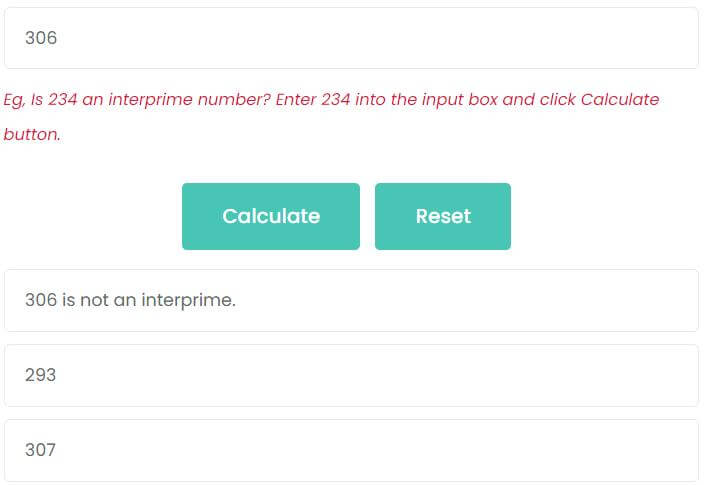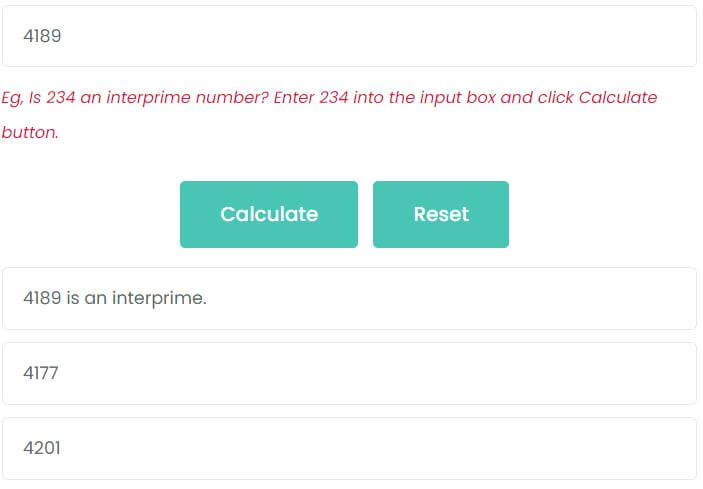Interprime Calculator is a free online tool used to check if the number is an interprime.
What is an interprime?
An interprime is the average of two consecutive odd primes. Note that it is an odd prime, so the prime 2 should be excluded. Consecutive primes indicate that there are no other primes between two primes. For example, 3 and 5 are consecutive primes. 7 and 11 are consecutive primes. 5 and 11 are not consecutive primes, because there is a prime number 7 between them.
Use tool to check if a number is prime: Prime and Composite Number Checker
Therefore, the first interprime is equal to the average of the first odd prime 3 and the second odd prime 5.
(3 + 5) / 2 = 4
4 is the first interprime.
How to check if a number is an interprime?
There are at least 4 steps to determine whether a number is an interprime:
- Find the prime number before the number.
- Find the prime number after the number.
- Calculate the average of the prime numbers found in the first and second steps.
- Compare the average and the number. If they are equal, the number is an interprime, otherwise, it is not.
For example, Is 2022 an interprime?
First, find the prime number before 2022, this prime number is 2017.
Second, find the prime number after 2022, this prime number is 2027.
Third, calculate the average of 2017 and 2027, which is (2017 + 2027) / 2 = 2022.
It can be seen from the above steps that 2022 is an interprime.
First 100 interprimes
| 4 | 6 | 9 | 12 | 15 | 18 | 21 | 26 | 30 | 34 |
| 39 | 42 | 45 | 50 | 56 | 60 | 64 | 69 | 72 | 76 |
| 81 | 86 | 93 | 99 | 102 | 105 | 108 | 111 | 120 | 129 |
| 134 | 138 | 144 | 150 | 154 | 160 | 165 | 170 | 176 | 180 |
| 186 | 192 | 195 | 198 | 205 | 217 | 225 | 228 | 231 | 236 |
| 240 | 246 | 254 | 260 | 266 | 270 | 274 | 279 | 282 | 288 |
| 300 | 309 | 312 | 315 | 324 | 334 | 342 | 348 | 351 | 356 |
| 363 | 370 | 376 | 381 | 386 | 393 | 399 | 405 | 414 | 420 |
| 426 | 432 | 436 | 441 | 446 | 453 | 459 | 462 | 465 | 473 |
| 483 | 489 | 495 | 501 | 506 | 515 | 522 | 532 | 544 | 552 |
How to use the interprime calculator
The procedure to use the interprime calculator is as follows:
- Enter the positive number.
- Click Calculate button to verify whether the input number is an interprime.
- Click the Reset button to start a new verification.
Solved examples using the interprime calculator
Example 1: Is 306 an interprime?
Enter 306 into the input box and click Calculate button, as shown in the figure, 306 is not an interprime.
The prime number before 306 is 293. The prime number after 306 is 307. Their average is 300.

Example 2: Is 4189 an interprime?
Enter 4189 into the input box and click Calculate button, as shown in the figure, 4189 is an interprime.
The prime number before 4189 is 4177. The prime number after 4189 is 4201. Their average is 4189.

Latest calculators
Standard Form to Slope-Intercept Form Calculator
Slope Intercept Form Calculator
Slope Calculator: Calculate Slope, X-Intercept, Y-Intercept
Reciprocal of Complex Number Calculator
Conjugate Complex Number Calculator
Modulus of Complex Number Calculator
Profit Percentage Calculator: Calculate Your Profitability Easily
Attendance and Absence Percentage Calculator
Circular Segment Radius Calculator
Regular Polygon Side Length Calculator
Annulus Calculator for Width, Perimeter, and Area